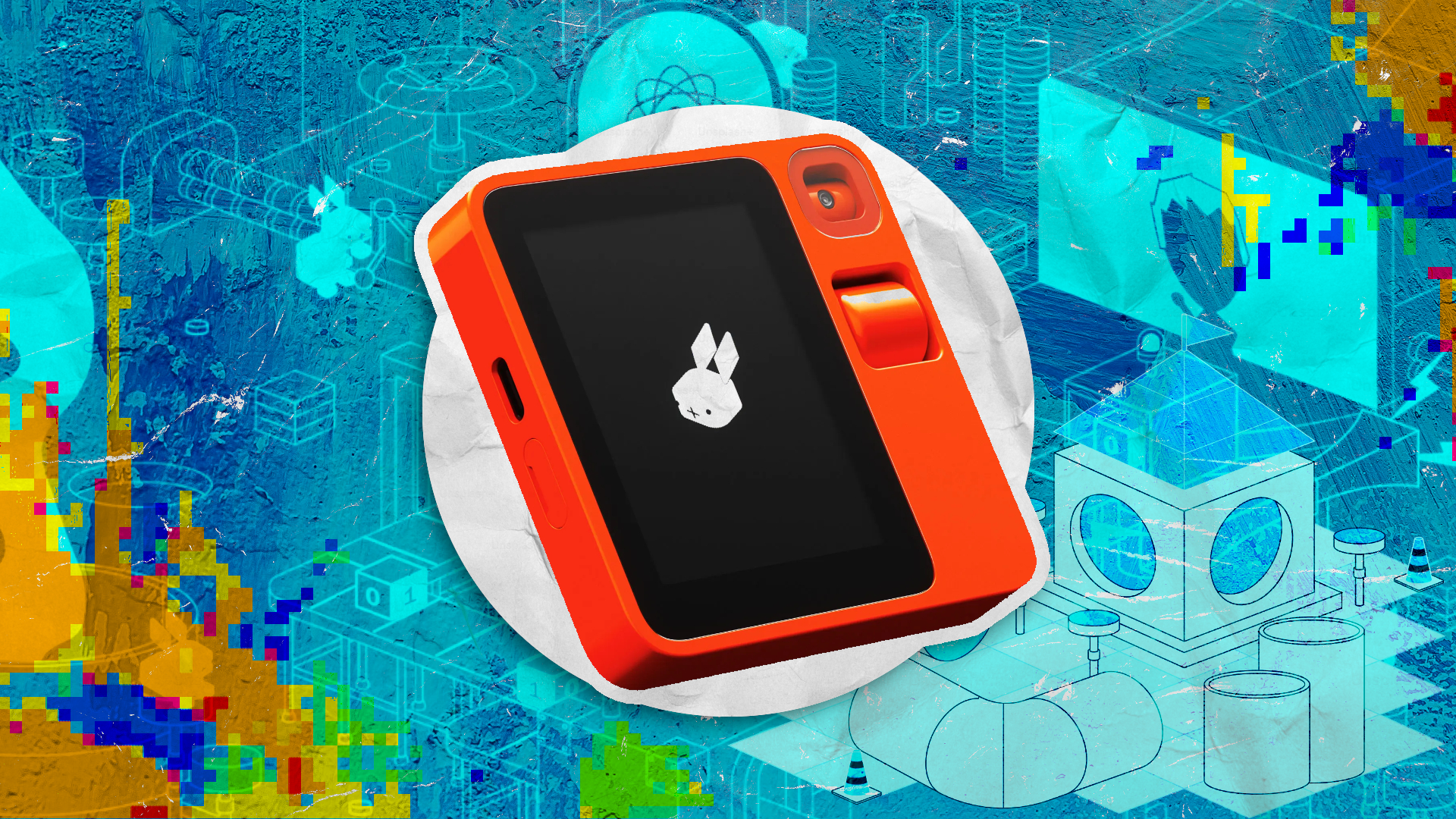
On January 9, 2024, Jesse Lyu unveiled one of the stars of CES 2024.
The pocket-sized device Lyu held during his virtual keynote speech was an eye-catching orange square with a cute animated rabbit bouncing on the screen. Lyu could ask the rabbit questions or have it complete simple tasks for him. The device even had a camera and thoughtfully designed physical buttons, a novel find in a world where smartphones are praised for having fewer buttons.
This cute, quirky device that took CES 2024 by storm wasn't a Tamagotchi revival. It was an AI assistant.
This device was the Rabbit r1, a dedicated AI device in the form of a pocket-sized physical companion built for running an AI assistant, similar to ChatGPT or Google Gemini. The difference is, those AI assistants run on an app on your phone. The Rabbit r1 was its own device, separate from your phone.
As Lyu explained in his virtual CES presentation, "Our mission is to create the simplest computer, something so intuitive that you don’t need to learn how to use it. The best way to achieve this is to break away from app-based operating systems currently used by smartphones. Instead, we envision a natural language-centered approach."
Our mission is to create the simplest computer, something so intuitive that you don’t need to learn how to use it.
Jesse Lyu at CES 2024
That "natural language-centered approach" consists of speaking or typing questions and requests. With its swiveling camera, the Rabbit r1 can also respond to questions with visual media, such as pointing the camera at something and asking the Rabbit r1 what it is.
In his half-hour keynote, Lyu showcased the Rabbit r1 as an intelligent, user-friendly companion that was "10x faster than most other AI projects" and capable of responding to requests. For instance, the Rabbit r1 has an Uber integration that theoretically allows you to order an Uber ride to your location by asking the device.
That sounds great, especially at just $199. Unfortunately for Jesse Lyu and the Rabbit team, buyers looking to journey down the rabbit hole experienced a short drop, and a sudden stop that fell far short of the depth promised at CES.
There's no argument that the Rabbit r1 is an absolute design beauty (more on that later.) However, the Rabbit r1 was a market and critical flop due to many issues and poor overall performance.
There's good news, though: A brighter future may lie ahead.
Rabbit r1: Price, promises, and the power of a cute design
Like many other AI devices launched this year, the Rabbit r1 set high expectations for itself in its original launch announcement, only to be a buggy mess when the product launched.
In his CES demo, Lyu used voice commands to play music, ask the r1 questions about it, order (and adjust) an Uber ride, and order a pizza, all in just a few minutes.
Unfortunately, real users had a very different experience when the device finally shipped in March 2024. At launch, it struggled to answer questions or accurately identify objects with its camera, and those handy app integrations were buggy and often unavailable.
Tom's Guide was just one of many who felt underwhelmed, giving the Rabbit r1 just 1.5 out of 5 stars, calling it "a retro-chic $199 AI device that looks way cooler than it performs."
To make matters worse, the r1's battery needed to be recharged numerous times daily and was missing basic capabilities like setting timers or creating calendar events.
Throughout the rest of the year, Rabbit released more than a dozen updates that addressed some of those initial issues, such as improved GPS for things like ordering Uber.
In September, Rabbit also released the LAM Playground, a web-based tool that allows you to teach the Rabbit r1's large action model (LAM) how to perform tasks for you. With this tool, you can (theoretically) teach the Rabbit r1 how to do anything you want without relying on app integrations.
Despite these updates, the Rabbit r1 still has a long way to go. If you want the r1 because of what Lyu and Rabbit promised it will be in the future, wait until it delivers on those promises before buying one.
That said, we would be wrong to write off the r1 as a failure altogether. It's easy to lump it in with the Humane AI pin because both are quirky AI devices launched at CES 2024.
However, the Rabbit r1 didn't flop in the same way the AI pin did. The Rabbit r1 exceeded expectations, at least on paper.

Is there a future for AI devices? The Rabbit r1 might be onto something
The Rabbit r1 wasn't the "iPhone of AI" in 2024, but could a future version claim that title? Right now, its capabilities are limited and need much fine-tuning and development. But if Rabbit can deliver on those promises, fix the bugs, improve the features, and make the AI more accurate and responsive, the Rabbit r1 might be a winning formula.
Forbes reported in June 2024 that the Rabbit r1 had sold 130,000 units worldwide, far beyond Rabbit's initial estimate of 10,000 units. To put that into context, the Humane AI pin had only sold about 10,000 units by then and was already considered a flop.
The Rabbit r1 even sold out its original pre-order batch of 10,000 units on the same day pre-orders opened after Lyu's January 9 CES presentation.
At $200, the Rabbit r1 is a fraction of the price of something like the Humane AI pin, making it far more accessible. Sure, that price doesn't include the cost of buying a cellular data plan for the Rabbit r1, but Rabbit doesn't require a cellular plan to use it.
The r1 also has a screen and a design similar to a traditional smartphone, making it much more approachable than a smart pin with a projector instead of a screen. Plus, the design from Teenage Engineering is undeniably cute and fun. Pair that with the charming rabbit avatar, and you get a device that makes AI seem more like a pocket-sized buddy than a massive algorithm a few lines of code away from becoming Skynet.
Those traits, price, and design, set the Rabbit r1 and the Humane AI pin apart. The r1 proved that there may be interest in novel AI devices when they come at the right price and don't take themselves too seriously. Sure, the Rabbit r1 is a device that could be an app, but it's a lot easier to justify a $200 AI device than an $800 one.
If there's one thing to learn from the Rabbit r1, perhaps it's a lesson in the power of design. The r1's design may be quirky, but it also makes AI seem fun, and that can go a long way — if the performance lives up to expectations. It maks me wonder, maybe the real reason the Rabbit r1 flopped was because it launched a few years too soon.

If you're anything from an AI enthusiast to the average AI tinkerer (or simply seeking out some of the additional features offered through Windows Copilot+ PCs or Apple Intelligence on Macs), then you'll need a powerful and performative laptop to keep up to speed with your needs.
At Laptop Mag, we review laptops year-round to ensure we're giving you expert-backed and up-to-date recommendations on which notebook is right for you. When it comes to the best AI PC category, our top picks are the excellent Asus Zenbook S 14 (UX5406) for Windows users and the impressive Apple Macbook Air M3 for those running macOS.
So, if you're shopping for a new laptop and looking to invest in an AI PC (or just a great laptop in general), check out our current top-tier picks below.

We love the MacBook Air 13 M3. Starting at just $1,099 (MSRP), with education pricing dropping to $999 (MSRP), the Air is a laptop we can recommend for just about any purpose. It's affordable, especially by Apple standards, and it features an excellent keyboard, fantastic performance, and outstanding endurance (over 15 hours of battery life), which makes it a great laptop for just about anyone's needs, especially those interested in getting to grips with all of the latest Apple Intelligence features.

The Asus Zenbook S 14 (UX5406) has quickly become our favorite AI PC laptop of the year, offering all the hallmarks of a great buy, including exceptional performance and battery life. This laptop is one of the first to feature an Intel Core Ultra 200V series processor and at just $1,499 (MSRP), you get a fantastic balance of power, a stunning 14-inch OLED display, effortless multitasking, NPU-enhanced performance for AI tasks, and all of the additional Copilot+ features available with Windows 11.







